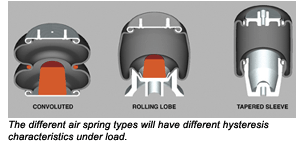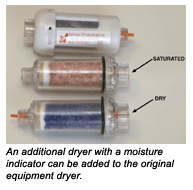ed air suspension to their SL sedans and limousines. Air springs returned in 1974 for the rear suspension of the new GMC Motor Home RV26. This time the springs came from Firestone and the compressor was driven by an electric motor. The mid 1980s saw a revival of air suspension at all four corners for Ford and other manufacturers.
Then there are air shocks. Delco, Gabriel and Monroe introduced them in the 1960s and air helper springs were made available by Air Lift. Air suspension systems came into wide use on class 8 heavy-duty truck and bus applications in the early 1980s. Today, air shocks and struts are part of the suspension on many vehicles to compensate for back seat passengers and luggage.
What makes air springs different?
There are significant differences between a coiled steel spring and an air spring. Engineers use the term “hysteresis” to describe it. Hysteresis is the loss of mechanical energy that occurs as a spring is cycled from loaded and unloaded and is proportional to the amount of deflection. The rubber products that make up the air spring do not react with the same speed as the steel coil spring. This makes the air spring slower to return to its uncompressed state. This difference in air spring reaction time requires different shock absorber valve configurations, when compared to a conventional coil spring to produce the same ride characteristics. All air spring suspensions are more complex than the conventional steel spring in that they require a compressor, solenoid valves, controls and plumbing.
Air Spring Types
Most passenger car original equipment air springs are of the rolling lobe (Goodyear /Air Lift), or tapered sleeve (Firestone). Rolling lobe and tapered sleeve air springs have a cylindrical sleeve that is rolled inward and attached to a mounting that is smaller in diameter than the sleeve. An end plate is attached to the other end. A convoluted air spring is constructed with one or more donut-shaped chambers that are sealed by end plates. For convoluted springs with more than one chamber, a band is used to contain each chamber. Air struts are a combination of a shock absorber and air spring.
 Compressor and Dryer
Compressor and Dryer
Most passenger and light truck compressors are a diaphragm-type that supplies an oil free air supply to the springs. A piston-type compressor is available for custom systems. The compressor is designed for intermittent service to inflate the air springs. Running the compressor for extended periods can over heat the compressor and damage the diaphragm or piston. It is very important to ensure that the source of air for the compressor is clean and as dry as possible.
The air in air springs makes them more vulnerable to damage and malfunctions than a conventional steel coil spring. When air is compressed, the water vapor contained in the air is condensed into a liquid. If there is no means of removing the water from the system, it will find its way to all parts of the system causing corrosion damage or freezing.
Most systems have a dryer that is connected to the compressor outlet to absorb the water entering the system. The dryer contains a moisture absorbing desiccant such as silica gel. The desiccant can hold a given amount of water and once the desiccant is saturated with water it will allow water to pass into the system.
The dryers that are installed on most systems do not have an indicator that will show when it is saturated and no longer able to absorb water. An additional dryer with a moisture indicator can be added to the original equipment dryer. It can be installed in the supply line and placed in a position where a periodic check can be made.
Mechanical and Solenoid Valves
There are various combinations of both mechanical and solenoid valves. The function of the mechanical or solenoid valve is to exhaust air from the spring(s). Each spring can have a valve. For the Lincoln air suspension system, there are five solenoid valves — one for each air spring or strut and one to exhaust air from the system. Most valves are used for a pair of load assist springs. The compressor unit contains a one-way check valve to isolate it from the springs or a reservoir. The Lincoln compressor has a combination one-way check valve and exhaust solenoid valve to inflate or exhaust the springs individually. Whether the valve is mechanical or solenoid, it needs dry air to operate properly.
Plastic line is used to transport air in the system in sizes 1/4”, 3/8” and 1/2”. Most fittings are push-on O-ring type ranging in size from 1/8” to 3/8” Male NPT.
Height and Leveling Sensor
Suspension activity requires that height sensors be non-contact using a Hall or magnetic sensing device. The sensor can be used to adjust for a load in the vehicle or used for dynamic vehicle trim. When the vehicle is stationary, the sensor adjusts vehicle height. For dynamic vehicle trim, the sensors will adjust overall vehicle height, as the vehicle is moving. Some systems offer a sensor that uses internal circuitry and doesn’t require a link to the suspension.
Control Panel and Controller
Custom systems can range an analog gage and switch with mechanical exhaust valve to all electronic system with wireless control and digital readout. The controller for an original equipment system is usually located with the compressor and dryer. It can receive direct input from a switch or can be connected to the vehicle data buss for system activation. Once the system is activated, the height sensor(s) will determine whether the compressor or exhaust solenoid valve is to be used to level the vehicle.
Dynamic Vehicle Trim
The Lincoln Continental Mark VIII is equipped with ride height sensors at each front wheel and one for the live rear axle at the driver’s side control arm. The sensors provide input to the controller for ride height. The suspension controller is programmed for two different ride heights. Parked, the vehicle will maintain this height by compensating for passengers and luggage. When the vehicle is put into gear, the controller will raise the suspension ride height 0.75 inch (20 mm). When vehicle speed exceeds 63 mph (105 kph) ride height is lowered by 0.75 inch (20 mm). When vehicle speed decreases to 45 mph (72 kph), the vehicle ride height is increased. The differential between 45 and 63 mph provides a dead band where the system will not adjust ride height. This prevents the system from cycling with small changes in vehicle speed. With the ignition off and doors closed, the vehicle returns to parked height.
The rear air struts on GM vehicles are used to assist the conventional coil springs. Cadillac vehicles with Road Sensing Suspension (RSS) have an electrically operated hydraulic valve located at the base of the air shock. There are sensors located at each wheel that supply input to the ride controller that operates the valves in the air shock and front struts. The suspension height sensor is located on the driver side control arm and the compressor is located in the rear suspension cradle.
 Where is the market today? The average age of a passenger car on the road today is nine years. An 18-year-old 1990 Lincoln will most likely receive the least costly repair with the air springs being replace with conventional coil springs. There are suppliers that can provide economical replacements for both springs and struts. The owner of an out of warranty 2004 vehicle will probably repair the air spring system.
Where is the market today? The average age of a passenger car on the road today is nine years. An 18-year-old 1990 Lincoln will most likely receive the least costly repair with the air springs being replace with conventional coil springs. There are suppliers that can provide economical replacements for both springs and struts. The owner of an out of warranty 2004 vehicle will probably repair the air spring system.
There are good reasons to consider adding a load leveling air spring kit to a vehicle. Loading of a vehicle can affect its handling characteristics.
Any vehicle equipped with a trailer hitch should have an air spring system. High Intensity Discharge (HID) headlights can present a glare problem when the aim of the headlights is raised by a load in the rear of the vehicle. Four percent of accidents investigated contain a claim of blinding glare from an on coming vehicle. In 2002, the National Highway Traffic Safety Administration began hearings to consider legislation for the color, height and aim of HID headlights. To date, there is no federal legislation and most states have dropped headlight aim from their inspections. The European Union legislation requires vehicles with HID headlights to have an aiming system to maintain headlight aim.
Air Lift, Firestone and other suppliers offer air springs and kits with compressor and plumbing to supply load compensation for all types of vehicles. Plus, there are air suspension manufacturers that offer a complete remake of the suspension from off road to low rider.









